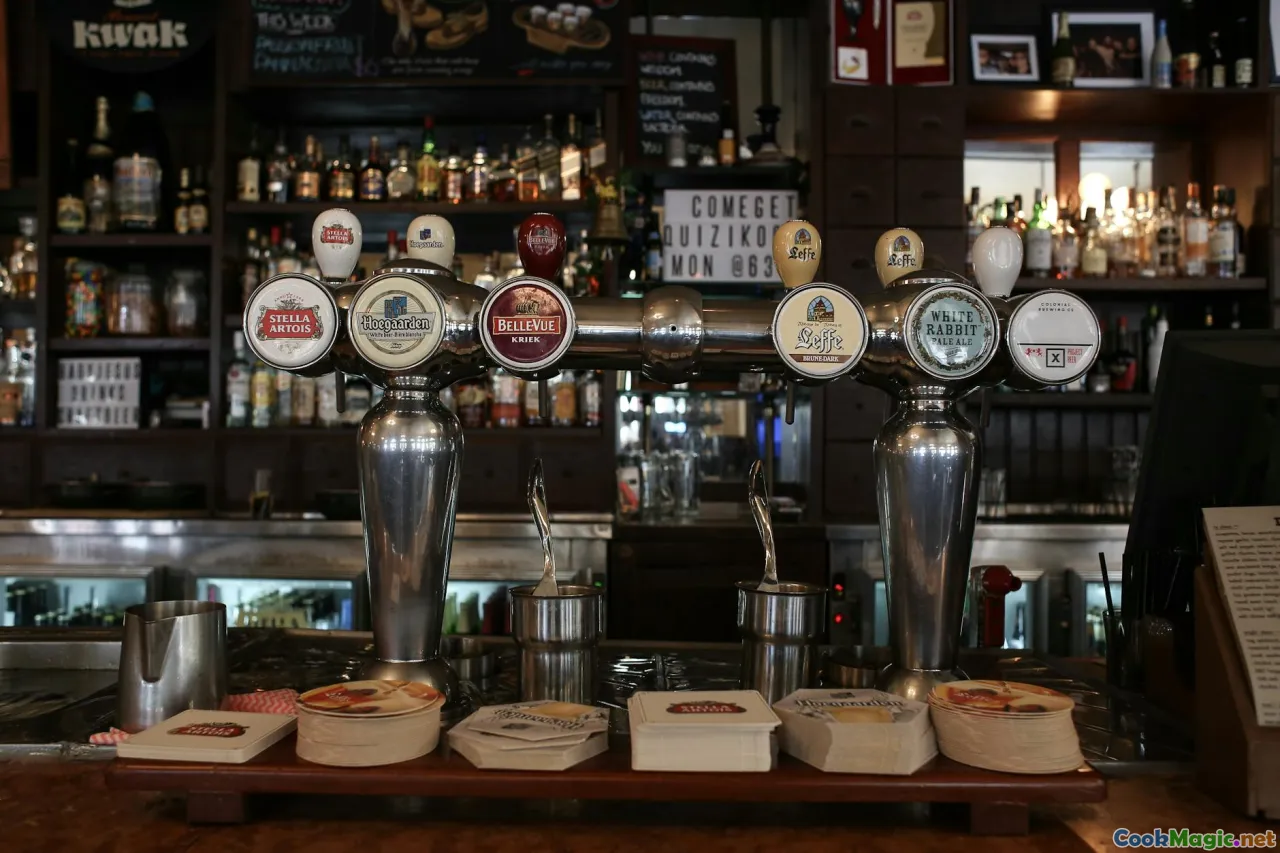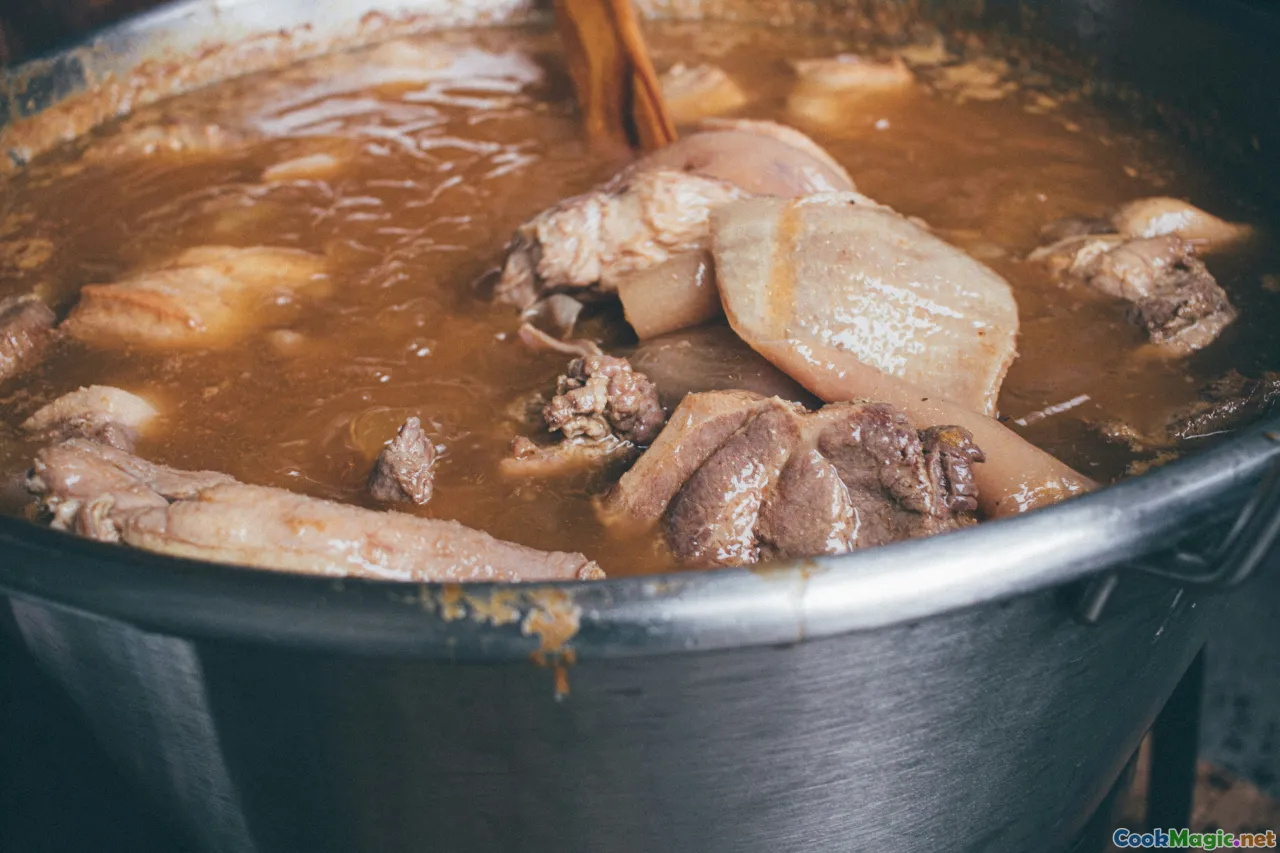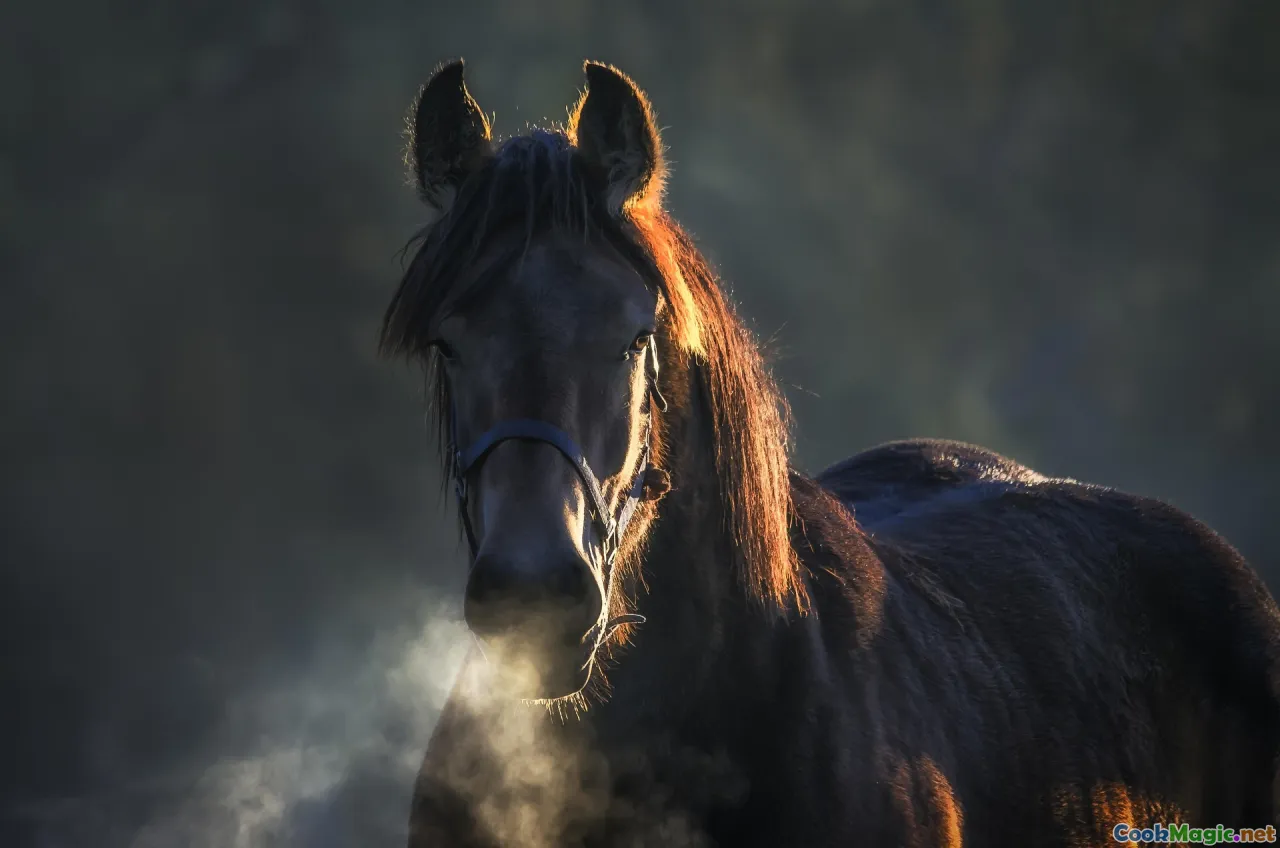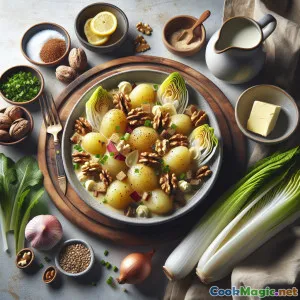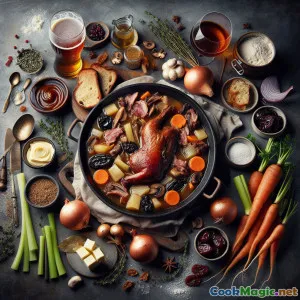
Món thỏ hầm bia Flemish với mận khô
(Flemish Ale-Braised Rabbit Stew with Prunes)
(0 Đánh giá)0
322
tháng 10 08, 2025
Báo cáo sự cố
Nguyên liệu
-
1200 grams Thỏ, cắt khúc
(Ask butcher to joint into 6–8 pieces)
-
500 ml Bia nâu Bỉ (Oud Bruin hoặc Dubbel)
(Authentic Flemish beer for depth)
-
250 ml nước dùng gà
(Ưu tiên ít muối)
-
150 grams Lardon ba chỉ hun khói
(Adds smokiness and fat for browning)
-
2 large Hành vàng thái lát mỏng
(About 350–400g total)
-
200 grams Cà rốt, cắt thành khoanh hình đồng xu
(About 2 medium)
-
100 grams Cần tây cắt lát
(About 2 ribs)
-
200 grams Nấm nâu, bổ tư.
(Cremini or chestnut mushrooms)
-
100 grams Mơ khô bỏ hạt
(Adds subtle sweetness and body)
-
2 tbsp Mù tạt Dijon
(Divided; some for bread, some for sauce)
-
2 slices Lát bánh mì kiểu quê
(About 60g; for traditional thickening with mustard)
-
60 grams Bánh gừng gia vị (pain d'épices)
(Use instead of bread for classic Flemish thickening)
-
2 tbsp Bột mì đa dụng
(For light dredging of rabbit)
-
2 tbsp Bơ không muối
(For browning and richness)
-
1 tbsp Dầu trung tính
(Raises searing point with butter)
-
1 tbsp Giấm táo
(Balances the malt sweetness)
-
1 tbsp đường nâu sẫm
(Softens bitterness; adjust to taste)
-
4 sprigs Nhánh cỏ xạ hương tươi
(hoặc 1 muỗng cà phê hương thảo khô)
-
2 leaves Lá nguyệt quế
(Khô hoặc tươi)
-
4 Berries Quả bách xù, nghiền nhẹ
(Subtle piney aroma; traditional touch)
-
3 cloves Tỏi (băm nhỏ)
(Freshly minced)
-
1.5 tsp Muối kosher
(Plus more to taste)
-
1 tsp Tiêu đen, xay mới
(chia)
-
1 tsp Vỏ chanh
(Bright finishing touch)
-
2 tbsp Ngò tươi thái nhỏ
(Để trang trí)
(Ask butcher to joint into 6–8 pieces)
(Authentic Flemish beer for depth)
(Ưu tiên ít muối)
(Adds smokiness and fat for browning)
(About 350–400g total)
(About 2 medium)
(About 2 ribs)
(Cremini or chestnut mushrooms)
(Adds subtle sweetness and body)
(Divided; some for bread, some for sauce)
(About 60g; for traditional thickening with mustard)
(Use instead of bread for classic Flemish thickening)
(For light dredging of rabbit)
(For browning and richness)
(Raises searing point with butter)
(Balances the malt sweetness)
(Softens bitterness; adjust to taste)
(hoặc 1 muỗng cà phê hương thảo khô)
(Khô hoặc tươi)
(Subtle piney aroma; traditional touch)
(Freshly minced)
(Plus more to taste)
(chia)
(Bright finishing touch)
(Để trang trí)
Dinh dưỡng
- Khẩu phần: 4
- Kích thước khẩu phần: 1 bát (350g)
- Calories: 610 kcal
- Carbohydrates: 0 g
- Protein: 52 g
- Fat: 28 g
- Fiber: 5 g
- Sugar: 10 g
- Sodium: 980 mg
- Cholesterol: 190 mg
- Calcium: 90 mg
- Iron: 5.2 mg
Hướng dẫn
-
1 - Prep and organize:
Pat rabbit pieces dry. Slice onions, carrots, and celery; quarter mushrooms if using. Mince garlic. Measure beer and stock. Preheat oven to 160°C/325°F (or prepare a gentle stovetop simmer).
-
2 - Season and dredge:
Season rabbit with salt and half the pepper. Lightly dredge in flour, shaking off excess. This promotes browning and gently thickens the sauce later.
-
3 - Render bacon:
In a heavy Dutch oven over medium heat, cook lardons in oil until browned and fat renders. Remove bacon to a plate, leaving the fat in the pot.
-
4 - Brown rabbit:
Add butter. Sear rabbit in batches until deep golden on all sides, 3–4 minutes per side. Do not crowd. Transfer seared pieces to the plate with bacon.
-
5 - Sweat aromatics:
Add onions, carrots, and celery. Cook, stirring and scraping fond, until onions soften and turn translucent, about 6–8 minutes. Add garlic and cook 30 seconds until fragrant.
-
6 - Deglaze with ale:
Pour in half the ale to deglaze, scraping up browned bits. Let foam subside and reduce slightly, about 2–3 minutes.
-
7 - Build the braise:
Return rabbit and bacon to pot. Add remaining ale, stock, 1 tbsp Dijon, vinegar, brown sugar, thyme, bay, juniper (if using), and remaining pepper. Bring to a gentle simmer.
-
8 - Traditional thickening:
Spread remaining 1 tbsp Dijon on bread slices OR use the gingerbread. Lay on top of the stew to dissolve as it cooks. Do not use both; choose one.
-
9 - Slow Braise:
Cover and braise in the oven at 160°C/325°F (or low simmer on stovetop) until rabbit is tender but not shredding, 75–90 minutes. Add mushrooms and prunes halfway if using.
-
10 - Finish the sauce:
Remove lid. If sauce is thin, simmer uncovered to reduce to a silky gravy that coats a spoon. Adjust seasoning with salt, a touch more vinegar, or sugar as needed.
-
11 - Brighten and serve:
Discard thyme stems and bay. Stir in lemon zest (optional) and scatter parsley. Serve hot with fries, buttered noodles, or mashed potatoes.
Pat rabbit pieces dry. Slice onions, carrots, and celery; quarter mushrooms if using. Mince garlic. Measure beer and stock. Preheat oven to 160°C/325°F (or prepare a gentle stovetop simmer).
Season rabbit with salt and half the pepper. Lightly dredge in flour, shaking off excess. This promotes browning and gently thickens the sauce later.
In a heavy Dutch oven over medium heat, cook lardons in oil until browned and fat renders. Remove bacon to a plate, leaving the fat in the pot.
Add butter. Sear rabbit in batches until deep golden on all sides, 3–4 minutes per side. Do not crowd. Transfer seared pieces to the plate with bacon.
Add onions, carrots, and celery. Cook, stirring and scraping fond, until onions soften and turn translucent, about 6–8 minutes. Add garlic and cook 30 seconds until fragrant.
Pour in half the ale to deglaze, scraping up browned bits. Let foam subside and reduce slightly, about 2–3 minutes.
Return rabbit and bacon to pot. Add remaining ale, stock, 1 tbsp Dijon, vinegar, brown sugar, thyme, bay, juniper (if using), and remaining pepper. Bring to a gentle simmer.
Spread remaining 1 tbsp Dijon on bread slices OR use the gingerbread. Lay on top of the stew to dissolve as it cooks. Do not use both; choose one.
Cover and braise in the oven at 160°C/325°F (or low simmer on stovetop) until rabbit is tender but not shredding, 75–90 minutes. Add mushrooms and prunes halfway if using.
Remove lid. If sauce is thin, simmer uncovered to reduce to a silky gravy that coats a spoon. Adjust seasoning with salt, a touch more vinegar, or sugar as needed.
Discard thyme stems and bay. Stir in lemon zest (optional) and scatter parsley. Serve hot with fries, buttered noodles, or mashed potatoes.
Thông tin thêm về: Món thỏ hầm bia Flemish với mận khô
Overview
Flemish Ale-Braised Rabbit Stew is a soulful, slow-cooked dish rooted in the beer-loving heart of Belgium. It marries tender rabbit with malty brown ale, smoky bacon, and a gentle sweetness from prunes, all buoyed by the savory backbone of onions and thyme. The result is a lustrous gravy—silky, balanced, and deeply aromatic—achieved using a very Flemish trick: thickening with mustard-smeared bread or spiced gingerbread (pain d’épices). This technique not only gives body to the sauce but also weaves in warm spice and malt notes that harmonize with the beer.
Why This Recipe Works
- Belgian brown ale (Oud Bruin or Dubbel): Its caramel, raisin, and lightly tart profile mirrors and enhances the stew’s complexity without overwhelming the delicate rabbit.
- Dredging and browning: A light flour coating builds color and provides natural thickening as the stew simmers.
- Layered thickening: Mustard-lathered bread or gingerbread dissolves into the sauce, bringing viscosity and subtle spice—traditionally used in carbonnade and adapted beautifully here.
- Balanced flavors: A touch of vinegar and brown sugar rounds out ale bitterness, while prunes lend fruity sweetness and body.
Ingredient Notes & Substitutions
- Rabbit: Ask your butcher to joint it, or substitute with bone-in chicken thighs if rabbit isn’t available. Adjust cooking time to avoid overcooking.
- Ale: Choose a Belgian Oud Bruin or Dubbel. If not available, a malty brown ale works better than a hoppy IPA, which can turn bitter.
- Thickener: Use either mustard-smeared country bread or pain d’épices. Gingerbread gives a subtle spice; bread keeps it neutral. Don’t use both.
- Prunes and mushrooms: Both are optional; prunes add sweetness and gloss, mushrooms add earthy savor.
- Bacon: Lardons add smoke and flavorful fat, but you can use pancetta or omit for a lighter stew. If omitting, add 1 extra tbsp of butter.
Technique Tips
- Searing: Work in batches so the rabbit browns deeply; color equals flavor. Crowding the pan steams the meat.
- Deglazing: Add the ale in two stages. The first loosens flavorful fond; the second builds the braising liquid.
- Gentle braise: Keep the simmer soft—too vigorous and the rabbit will toughen or shred. Aim for fork-tender, not stringy.
- Final balance: Taste the sauce at the end. If it’s slightly bitter, add a pinch of sugar. If it’s flat, a splash of vinegar brightens it. Salt brings it all together.
Serving Suggestions
- Classic Belgian sides: Crisp frites, buttered egg noodles, mashed potatoes, or stoemp (mashed root vegetables).
- Greens: Bitter greens lightly dressed with mustard vinaigrette complement the stew’s richness.
- Beer pairing: Serve with the same style you cooked with—Oud Bruin or Dubbel. For wine, try a light-bodied red like Pinot Noir or a rustic Gamay.
Make-Ahead, Storage, and Reheating
- Make-ahead: Like many stews, this improves overnight as flavors meld. Cool quickly, refrigerate up to 3 days.
- Freezing: Freeze in airtight containers for up to 2 months. Thaw in the fridge overnight.
- Reheating: Warm gently over low heat with a splash of stock or water. Avoid boiling to keep the rabbit tender.
Cultural Notes
Belgium’s culinary identity is inextricably tied to its beer. Stews such as carbonnade flamande (beef and beer) and rabbit with prunes are fixtures at brasseries and family tables alike. The practice of thickening with bread or gingerbread reflects frugality and ingenuity, turning pantry staples into culinary advantage. Flemish ale-braised dishes are about balance: malty sweetness, subtle bitterness, a whisper of acid, and the comforting depth of slow-cooked onions.
Troubleshooting
- Sauce too thin: Simmer uncovered to reduce. If needed, mash a small cube of gingerbread into the sauce to tighten.
- Sauce too thick: Add warm stock or a splash of ale; whisk until glossy.
- Bitter finish: Stir in a pinch of brown sugar and a few drops of vinegar; simmer 2–3 minutes and retaste.
- Rabbit dry: It likely overcooked at a high simmer. Next time, reduce heat and check 10–15 minutes earlier.
Chef’s Notes
This stew thrives on patience and good beer. Choose a malt-forward ale and let the oven do the quiet work. The juniper berries are a subtle nod to the forests of Northern Europe; they’re optional but contribute a whisper of pine that keeps the richness lively. I love finishing with lemon zest—it’s not traditional, but the citrus oils make the flavors pop without adding noticeable acidity.
Bringing this pot to the table is half the joy: lift the lid, breathe in the malty steam, and ladle over something starchy and comforting. It’s a dish that tastes like winter sundays and pub warmth—anchored in Flemish tradition, yet endlessly welcoming to your own touches.

